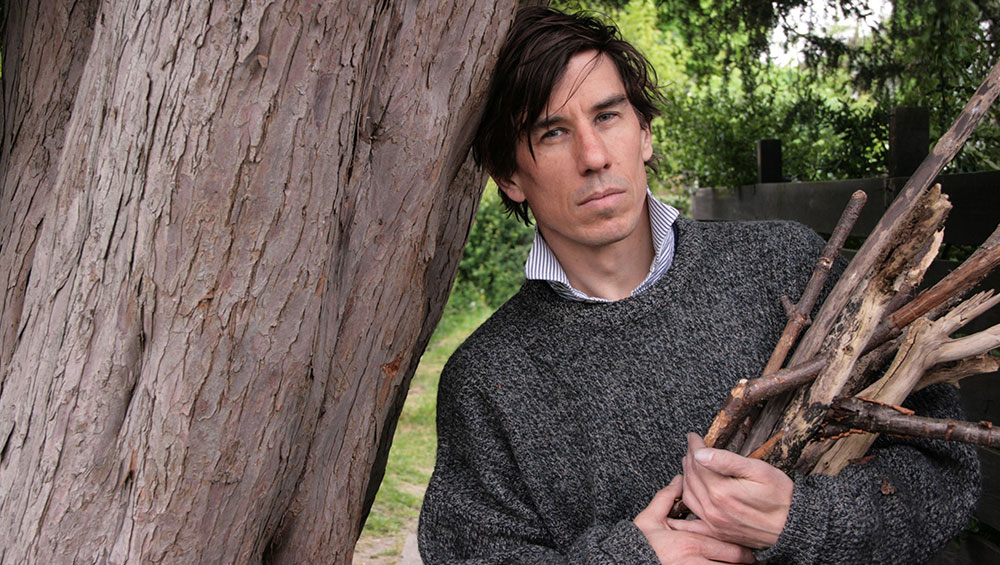
Graham Little. Courtesy: Alison Jacques, London; Photo: Robert Orchardson.
by JOE LLOYD
The people who populate the muted, meticulously arranged gouaches of Graham Little (b1972, Dundee) are usually preoccupied. They stare into the distance or gaze inwardly, water plants or read books. They are often surrounded by objects, artefacts and chic decor. The protagonist of Untitled (Stairway) (2020), clad in a red-and-beige pyjama two-piece, is frozen mid-dance before a wooden-sided modernist staircase, which feels as integral to the scene as the lady. In Untitled (Bedroom) (2021), a reclining woman points towards a bare-chested man holding a golf ball. There is a surrealism in the stillness.
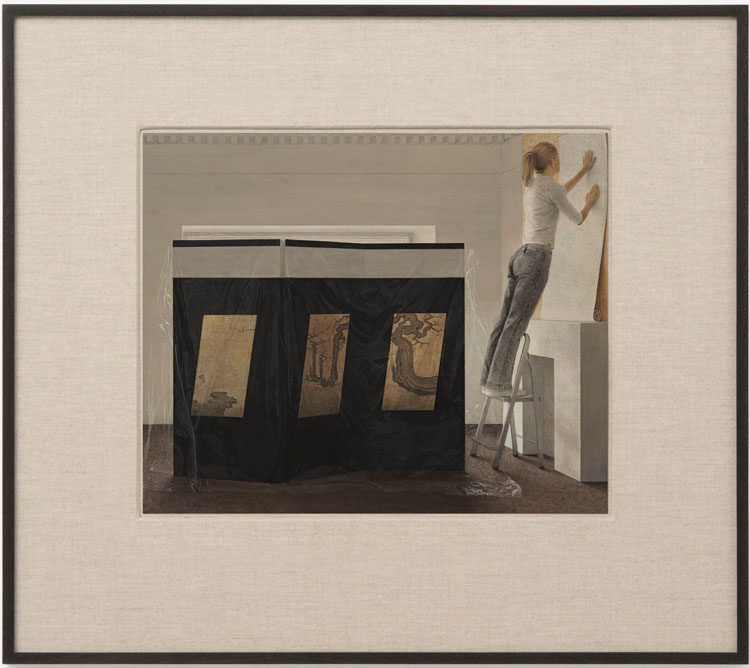
Graham Little, Untitled (Ladder), 2020. Gouache on paper, 38.9 x 47.1 cm (15 1/4 x 18 1/2 in). Courtesy: Alison Jacques, London © Graham Little.
There can be intimations of reference — one 2014 work shows a woman resting before a water-filled landscape that could be straight out of the Renaissance, except for a modern barn. Critics have drawn on a range of possible precedents: Chardin’s quietude, the light of Caravaggio, Gainsborough’s faces, Morandi’s objects. Yet Little’s world is his own. It has a calm timelessness. His clothes and furnishings come from different eras and styles. His compact pictures, themselves surrounded in a thick cloth border, feel like windows into dreams. Despite their small size, many contain a certain vastness.
Little has a particular way of working. His models and backgrounds are adapted from magazines, books and catalogues. He translates photography into paint, rendering one posed form into another. His earlier, more portrait-like works bear the clearest relationship to their origins in fashion magazines, with a finely clad protagonist stealing the scene. More recently, the people become one element in the world around them, sharing space with landscape and still-life. Previously, Little depicted only female characters. His practice raises interesting questions about the male gaze: by depicting his characters in moments of strength and self-determination, is he refuting the voyeurism that runs through the male-dominated history of painting?
Studio International met Little before his exhibition of new paintings at London’s Alison Jacques Gallery, open now.
Joe Lloyd: Have the events of the past year-and-a-half affected your practice?
Graham Little: It doesn’t feel that different. I work at home, and it’s very similar. I just suppose I was working three times as hard — of course, not three times as much! I think the hardest thing I really felt, that everyone felt, was how things were going to be financially. And, then, the sort of invisible things that were happening to people which we don’t know about.
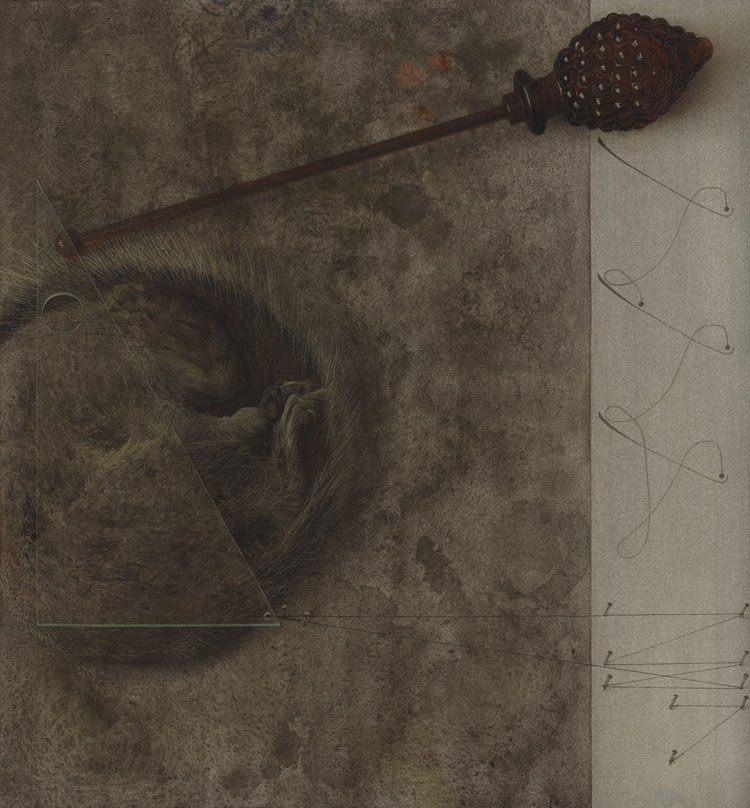
Graham Little, Untitled (Squirrel), 2021 (detail). Gouache on paper, 33.3 x 31 cm (13 1/8 x 12 1/4 in). Courtesy: Alison Jacques, London © Graham Little.
JL: Why do you work from home?
GL: Working at the house, I can pretend it’s a hobby. And all the things that are really important, they’re at home: the books. I tried 15 years of working in a studio and I’d end up just taking things that I liked back and forth, and it got heavy — no rucksack is big enough. And studios can be really industrial and bleak, and freezing cold and boiling hot. It’s funny how artists seem to want that when it feels the hardest to me.
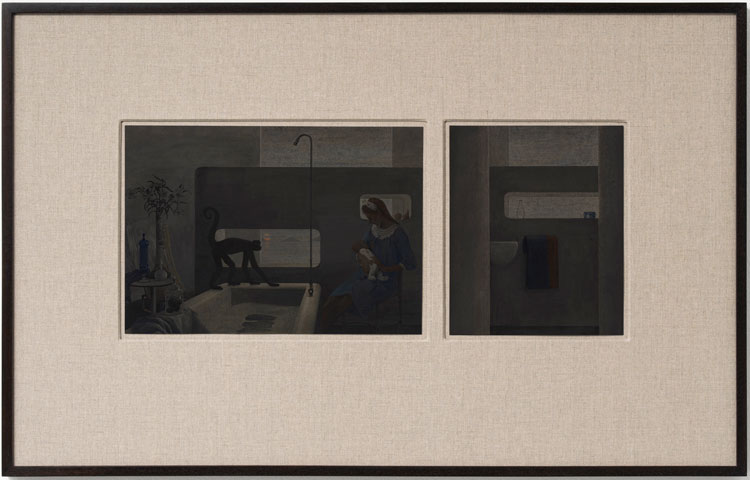
Graham Little, Untitled (Mother and Baby, dusk), 2020. Gouache on paper, 24 x 34.4 cm (9 1/2 x 13 1/2 in) right panel: 24 x 20 cm (9 1/2 x 7 7/8 in). Courtesy: Alison Jacques, London © Graham Little.
JL: There are lots of beautiful home interiors in your gouaches. One in this exhibition shows a mother and baby in a sleek modern bathroom, while a sinister monkey lurks on the edge of a tub.
GL: That one might be the oldest one. It was made after another piece, and I was interested to see that situation in a different way. In some ways, it is about my understanding, our understanding as men, of femininity as a whole, but also pregnancy, having a child, breastfeeding. We see it at times in a wrong way, at quite a tangent. So, it’s just trying to get that feeling across.
I’m always amazed at how strong women are. Children are incredibly vulnerable, and mothers have so much responsibility. And it’s so significant, every decision they make with the child. And that requires so much strength, that men don’t necessarily have to deal with. I think it’s curious that when you see men in play parks with their children, you see the dads pushing the swing, totally disengaged, looking at the phone or the sky.
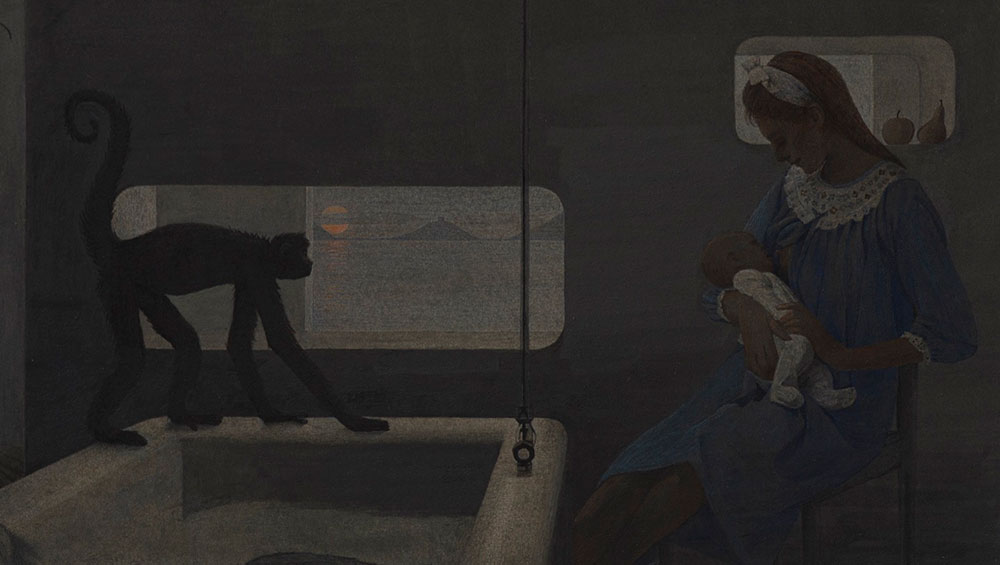
Graham Little, Untitled (Mother and Baby, dusk), 2020 (detail). Courtesy: Alison Jacques, London © Graham Little.
JL: Although men feature in some of your newer works, the majority to date feature female protagonists. Why?
GL: I think the paintings are generally trying to understand and process my misunderstandings about femininity. I suppose, for a long time, that felt more productive. They began as essentially quite literal translations of photographs from fashion magazines. And the process of that felt like a drug: it felt lovely to be immersed in that femaleness and forget about male crimes and all my failings. And it did feel very addictive. With time, there’s been, just gradually, a coming back from that.
JL: Illustrations for magazines are interesting in terms of audience.
GL: That’s the most intriguing part. Which comes first? Even if it’s an image from a catalogue of a beautiful woman — perhaps those images are for women to then think about how they might like to see themselves or identify themselves or dress themselves, you know — is it coming from the fact that women feel they need to present themselves in a certain way for men? So, in a sense even that itself is for the male gaze, maybe. I’m not saying it is, but I wonder. The dominance of male power is so huge that I wonder if there’s anywhere where it doesn’t exist.
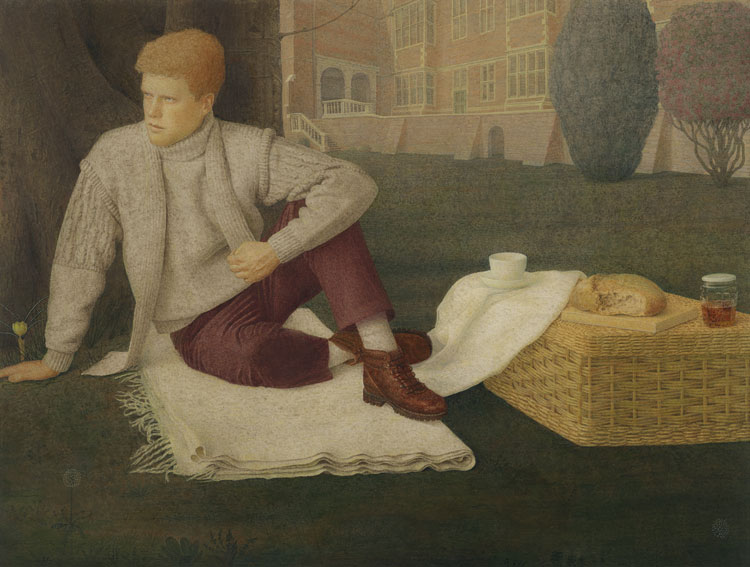
Graham Little, Untitled (Garden), 2021. Gouache on paper, 25.6 x 33.7 cm (10 1/8 x 13 1/4 in). Courtesy: Alison Jacques, London © Graham Little.
JL: Apart from magazines, where do you source your subjects?
GL: Generally, one to three days a week, I’ll be nipping into a charity shop and finding things that way. I always have. And I’ve got such a quantity now that I can live off them for some time.
[Gesturing around the room] That one was from a book on knitting — he was posed in the studio on a blanket. And she was from a Mothercare advert — it was when Terence Conran took over in the 80s. But this other interior is, for example, from an obscure German interiors book. Those two are friends. And the squirrel was in my freezer for about three years; I found it while cycling. And he was in a fashion advert, and then the interior was made up and the exterior partially made up, partially not.
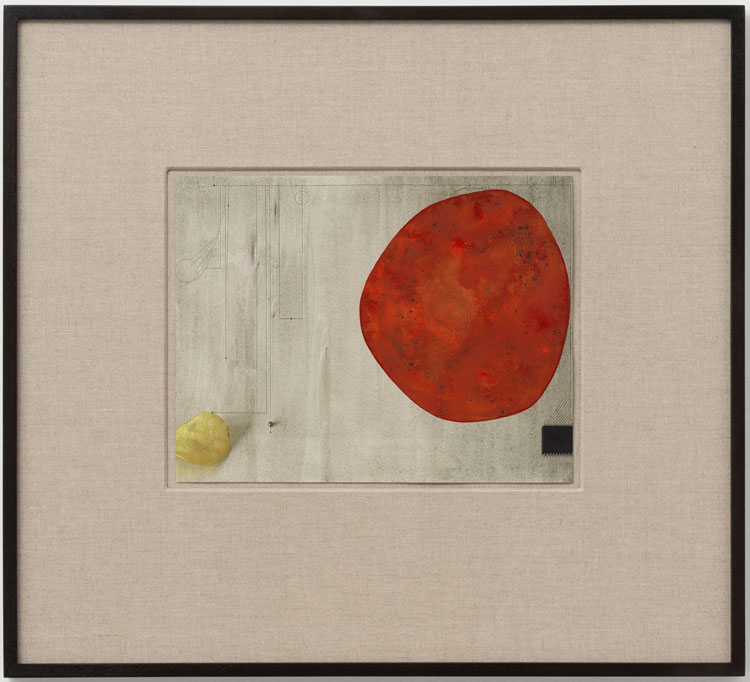
Graham Little, Untitled (Crisp), 2021. Gouache on paper, 25.8 x 33.5 cm (10 1/8 x 13 1/4 in). Courtesy: Alison Jacques, London © Graham Little.
JL: What makes you choose a particular image?
GL: It can sometimes start with an object, it can sometimes start with just an idea. But, typically, in the past it has started with an image of a person. Then you just try to understand either what the photographer, or the writer in the publication, wanted to say in that photograph, and you try to help them with that idea. Or, you’ve seen something in that photograph that the photographer wasn’t intending and you then contradict the photographer. Or maybe you fantasise about what the figure would want if they really existed in life. I know they’re posed to have a certain fiction. But if that really was happening to them, what exactly would be their feelings? I suppose I’m trying to empathise. I suppose by doing that I can fantasise that I’m not involved in the male gaze because I’m essentially involved in a different relationship, but whether that’s true or not, I don’t know. It’s true to a certain extent perhaps, but it feels desirable for me!
JL: I know your work very slowly. Do you tend to paint one at a time?
GL: Usually one at a time. They involve different source material, and different sketches and different ways of thinking. And I tend to do things in life how I can manage. But sometimes I do make more than one at once. It’s actually OK, I can do it. Sometimes it’s all right. But it’s usually just working on one and then the next one.
JL: There is a sort of timelessness in your work. One of your new paintings, Untitled (Bedroom) (2021), shows characters in modern dress and surrounded by modern design but posed in a matter that reads as ancient.
GL: I’ll tell you a little story about this one. It comes from a book of Etruscan paintings. I had it for a long time, and I had an idea for a painting. I looked at the painting on the page and I thought: “Oh, it’s a couple who seem to be having an argument; he seems to be holding up a golf ball from an era when they didn’t have golf balls. And I don’t understand at all why that would be.” It really mystified me. For a long time, I really wanted to make that painting, but I couldn’t work out how to do it.
Then, years later, I looked at the book again and found on another page that it was a black-and-white image of a whole frieze, a massively long frieze. And, of course, she's sitting like the Ancient Greeks, sitting eating. And he’s holding a piece of bread, not a golf ball! So, I thought: “Well, I’ll paint my misunderstanding of the painting.” I kept it as a golf ball, and then kept my misunderstanding that she was in bed, and the feeling that they might be having a misunderstanding.
I suppose I prefer making work that’s a little bit more about the vulnerability of being human than anything else, or dealing with my experience of feeling fairly vulnerable most of the time. But, also, although they’re very impassive, she’s pointing at something, it’s a little bit aggressive. And he’s also got the potential, although it’s a small ball, to use that ball in a potentially violent way. I don’t want that to be the meaning of it, necessarily, but just to gently suggest it.
I also wanted the darker-hued figure to be more dominant. You know in Manet’s Olympia (1863), for example, where there’s a dark-skinned figure and it feels secondary. Because of the colour scheme of the painting, that figure disappears into the background and Olympia flies forward. I wanted to try to get it the other way around here. That let me have more opportunity to objectify the man. I realised making it that the whole history of painting with dark backgrounds is with a hierarchy of sorts for white people. I don’t know if anyone has pointed it out. It seems so obvious now.
JL: By contemporary standards, your paintings are minute. Why so?
GL: They feel more manageable. When you look at a huge Rothko, it is supposed to be immersive. There’s the idea that you are completely in that world when you’re looking at it because it’s so huge. Well, I find the opposite is true. When you look at, say, a Gerald David or a tiny Raphael, you’re only less than a metre away, no one is going to walk in front of you, nothing’s going to interrupt. But if you’re in front of a Rothko, other people may well get in front of you. I want my painting to be as intimate as possible because I think that allows that to happen. And smallness feels natural to me — when I write anything I write in tiny, tiny writing.
JL: Although often set in interiors, your works increasingly contain glimpses of the exterior landscapes. Why?
GL: I felt the need for them more and more when I tried to gain distance from the female figures. I think they started with the feeling that the female figures had a life outside the interior. Which felt important, so they weren’t feeling trapped inside that house, which obviously for the history of female existence can be a bit of a truth. It felt more enjoyable to give that fictional character the ability to have a life outside the house.
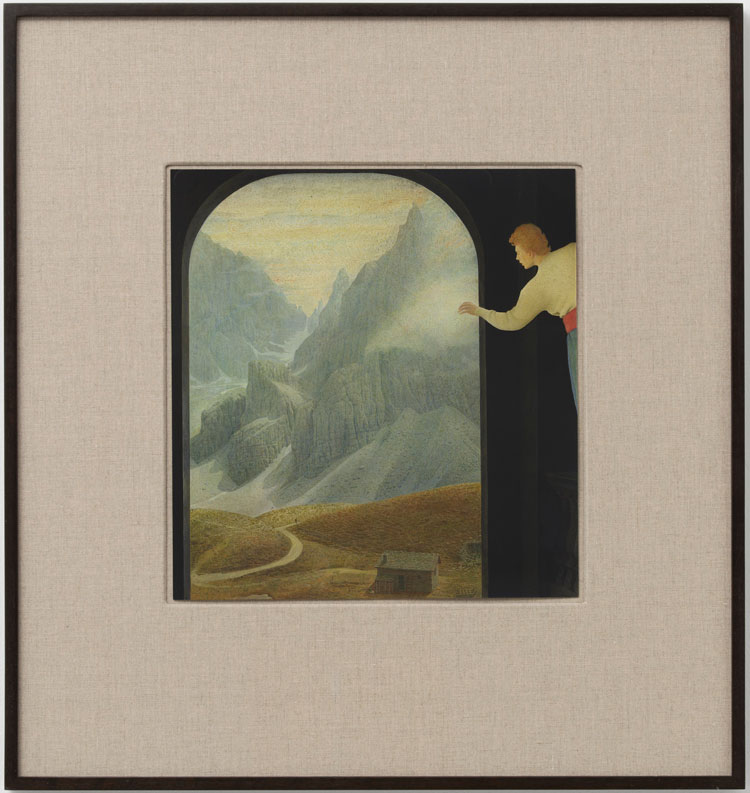
Graham Little, Untitled (Mountain), 2021. Gouache on paper, 36.5 x 34.6 cm (14 3/8 x 13 5/8 in). Courtesy: Alison Jacques, London © Graham Little.
JL: One work here, Untitled (Mountain) (2021), features a vast, detailed mountain landscape.
GL: I was very much brought up outside. I longed to go to art museums, which we didn’t do once. I’d go on my own. As a family, we would climb mountains. My dad was quite a serious mountaineer, so we’d be there all the time. But, this was in the 80s, we didn’t have much money, so we had really bad equipment. We had boots with holes in them, waterproofs that — in Scotland where it’s raining all the time — would get soaked in 20 minutes. We were all freezing cold for a whole day on a mountain.
Painting that, quite a lot of feelings came out. I think maybe one aspect of the figure is that it could possibly be my soul reaching out into the past, if you look at it psychoanalytically. I think, because I was brought up that way, I pictured life as being about survival. Even coming to London, I imagined that I’d have to live in a bush in Hyde Park for a few years until I could make it. Thankfully, I didn’t have to do that, though I came a bit close
JL: There is a tiny little person in the centre of the path.
GL: Yes, there is. And [the larger figure] is potentially reaching forward to that figure, who could be from a different time, or from his imagination — the whole landscape could be imagined, he could be dreaming it. I like to leave it completely open for all those scenarios so it feels more generous to the viewer: they can be right in lots of different ways.
• Graham Little is at Alison Jacques Gallery, London, until 6 November 2021.
Click on the pictures below to enlarge